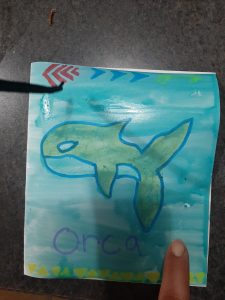Competency #6 Teacher should be able to identify strengths and weaknesses related to their professional role with students with exceptionalities.
Artifact: Resume of Professional Experience Jennifer’s Resume
Reflection: for Resume Artifact Reflection on Resume
Art by Jennifer Desgagnes
Competency #25 Teacher will be able to comment critically on a current issue facing teachers in regards to inclusive education.
Artifact: Critique a journal article on a current issue in special education. http://dx.doi.org.ezproxy.tru.ca/10.1177/1053451214546402
Critique of Journal Article on a Current Issue in Special Education
Reflection:Reflection on Journal Article
Competency #27 Teacher will be able to defend why segregated classrooms are not the best learning environment for students with exceptionalities
Artifact: 2 Guardian Interviews
Guardian interview #1, Exceptionality ADHD
Guardian Interview #2, Exceptionality ASD and ADHD
Reflection: Reflection for Gaurdian Interviews
Competency #32 Teacher will be able to design and implement an activity for students with exceptional learning needs
Artifact: Video of Sensory Break
Reflection: Reflection on Video of Calming Sensory Break
Competency #40 teacher will be able to include evidence of Indigenizing lesson plans;
Artifact: Indigenization and inclusive education: what does this mean exactly? What are the current challenges/successes? Here are some examples of how I Indigenized lesson plans and made my practice inclusive. Indigenizing & Inclusive Education Artifact
Reflection: Reflection on Indigenization and Inclusive Education
EVIDENCE of InDIgenizing lesson plans
Integrated Storytelling Lesson, grade 1-3
This lesson can bring up some challenges around possible triggers. I will go more into this during my reflection of these three artifacts.
Indigenous Poetry Lesson, Grade 2/3
Indigenous Poetry, Lesson Plan #4 Template
This lesson is on Indigenous poetry for a grade 2/3 class. The lesson is used to support early learning about animals and resources that are important to Aboriginal people in British Columbia and brings in Indigenous content. Aboriginal worldviews are an integral part of the English Language Arts curriculum, as all students learn about themselves and others as Canadians. Poetry can give students a healthy outlet for surging emotions. Reading poetry aloud in class can foster trust and empathy in the classroom community, while also emphasizing speaking and listening skills.

Indigenous SCIENCE LESSON, GRADE 4-7
https://www.loom.com/share/7678d1fbe68546f29e7a031ac5dd1d92
This was an Indigenous lesson that I developed for SD73 for teachers that was presented during a ProD Day. Success is that it was well received in the school district. The lesson covers the cultural tie between wolves and Indigenous Peoples. It explains the wolf’s adaptations to the environment, as well as how it uses its senses such as scent, hearing, sight, and communication for survival. Students learn about cryptochromes which are light-sensitive molecules that exist in bacteria, plants, and some animals, and are involved in the control of the body’s circadian rhythms. Wolves use three different languages to communicate. Students learn about how living things such as wolves sense, respond, and adapt to stimuli in their environment through prey and hunting. How wolves influence other species and ecological processes and the impacts of one species on another. Students learn how components of an ecosystem affect each other. They learn about concepts of biodiversity, what is biodiversity? What threatens biodiversity? and why is biodiversity important. Students learn the definition of mesocarnivores. They participate in an activity where they make predictions of what will happen if an ecosystem is depleted of wolves and how the presence of wolves changes an ecosystem. They look at the distribution of wolves across North America. Then watch a video on a study that biologists are conducting on wolves and dogs, where scientists discover that curiosity stands out as the main difference between domesticated dogs and wolfs. There is a simple case study at the end of the lesson which is used as a formative assessment. Students ultimately learn how sensing and responding are related to interdependence within ecosystems. They learn why wolf recovery is critical in maintaining a healthy ecosystem.